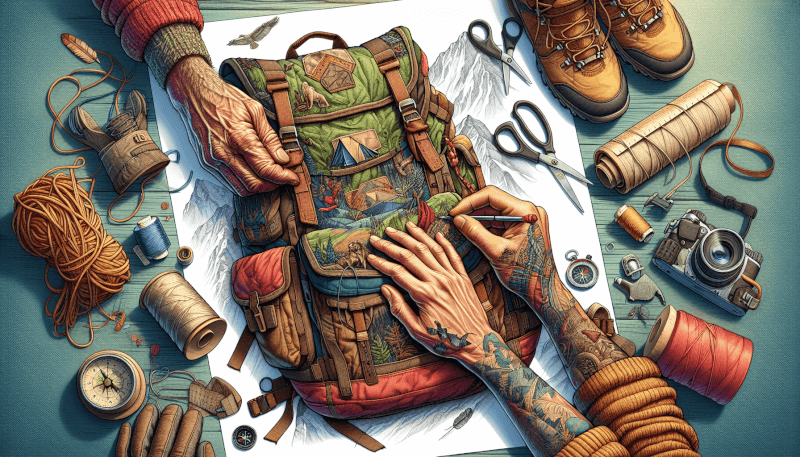If you’re an adventure enthusiast who loves spending time in the great outdoors, then you know the importance of having reliable gear. Whether it’s a sturdy backpack, a durable tent, or a weatherproof jacket, having equipment that can withstand the elements is essential. But have you ever wondered how all these outdoor gear items are made? In this article, we’ll explore the fascinating world of sewing outdoor gear and discover the skills and techniques required to create equipment that can handle even the toughest of terrains. From understanding different types of fabrics to mastering intricate stitching patterns, get ready to dive headfirst into the world of sewing outdoor gear.
Choosing the Right Materials
When it comes to sewing outdoor gear, choosing the right materials is crucial for durability and functionality. Consider the purpose of the gear you are making and select fabrics accordingly. Are you sewing a rain jacket, a tent, or a backpack? Each gear has different requirements in terms of fabric strength, water resistance, and breathability.
It is important to select durable and weather-resistant fabrics for your outdoor gear. Look for fabrics that are made to withstand the elements and provide long-lasting performance. Nylon and polyester are popular choices for outdoor gear due to their durability and ability to repel water.
In addition to durability, it is advisable to choose fabric with UV protection. When spending time outdoors, our gear is constantly exposed to the sun’s harmful UV rays. Fabric with UV protection helps to shield you from these rays, reducing the risk of sunburn and protecting your skin.
Essential Tools and Equipment
To effectively sew outdoor gear, you will need a set of essential tools and equipment. These tools will assist in achieving professional results and make your sewing experience more efficient. Here are some must-have tools for sewing outdoor gear:
Sewing Machine: A reliable sewing machine is the backbone of any sewing project. Look for one that offers a variety of stitches, including straight and zigzag stitching, to accommodate different fabrics and techniques.
Thread: Choose a high-quality thread that is strong and durable, suitable for both outdoor and heavy-duty applications. You want your stitches to withstand the strain and wear that outdoor gear often encounters.
Needles and Pins: Invest in a selection of needles and pins suitable for the fabrics you will be working with. Sharp and sturdy needles are necessary for sewing outdoor gear and ensuring clean and secure stitches.
Fabric Scissors: A pair of fabric scissors specifically designed for cutting through tough materials is essential. Keep them sharp for clean and accurate cuts.
Measuring Tape: Accurate measurements are crucial in sewing. A reliable measuring tape allows you to take precise measurements and ensure proper fit and proportions.
Seam Ripper: Mistakes happen, and a seam ripper is a handy tool for undoing stitches without damaging the fabric. It will save you time and frustration when adjustments or fixes are necessary.
Marking Tools: Marking tools such as tailor’s chalk or fabric markers are essential for marking and indicating important points on your fabric. They help you stay organized and keep track of measurements and markings.

Basic Sewing Techniques
Mastering basic sewing techniques is essential for sewing outdoor gear effectively. Here are some fundamental techniques to familiarize yourself with:
Straight Stitching
The straight stitch is the most basic and commonly used stitch. It is ideal for joining fabrics together and creating strong and secure seams. Practice stitching a straight line on scrap fabric to gain confidence and control.
Zigzag Stitching
A zigzag stitch is useful for finishing edges, preventing fraying, and adding stretch and flexibility to your seams. It is commonly used for sewing stretchy fabrics and reinforcing corners and edges.
Topstitching
Topstitching is a decorative and functional technique used to secure seams and add professional finishing touches. It is done on the right side of the fabric and adds strength and stability to your stitches.
Overlocking
Overlocking, also known as serging, is a technique used to finish raw fabric edges. It prevents fraying and adds durability to your seams. If you don’t have a serger, you can achieve a similar effect using a zigzag stitch.
Gathering
Gathering is a technique used to create controlled gathers or gathers in fabrics. It is often used in garments with ruffles or for adding fullness to skirts or sleeves. Gathering adds volume and creates visual interest.
Hemming
Hemming refers to the process of finishing raw edges and creating a neat and clean edge on garments or gear. There are various hemming techniques, such as rolled hem, blind hem, or double-fold hem, depending on the fabric and desired finish.
Sewing Gear for Backpacking
If you love backpacking and spending time in the great outdoors, sewing your own gear can enhance your experience and make your adventures more enjoyable. Here are some essential sewing gear items for backpacking:
Backpack Rain Cover
A backpack rain cover is a must-have when backpacking in wet weather conditions. Sewing your own rain cover allows you to customize the fit and design to perfectly match your backpack.
Sleeping Bag Stuff Sack
A stuff sack is essential for keeping your sleeping bag dry and compact during your backpacking trips. Sewing your own stuff sack gives you the freedom to choose the size and fabric that best suits your needs.
Tent Repair Kit
A tent repair kit is invaluable for fixing any tears or damages to your tent while camping. Sewing a repair kit allows you to include patches, spare fabric, and other necessary supplies to keep your tent in top condition.
Packable Kitchen Utensil Roll
A packable kitchen utensil roll is a convenient and organized way to store your cooking utensils while backpacking. Sewing your own utensil roll allows you to customize the size and layout to accommodate your specific needs.

Sewing Gear for Camping
Camping enthusiasts know the importance of having functional and comfortable gear. By sewing your own camping gear, you can create personalized items that enhance your camping experience. Here are some sewing gear ideas for camping:
Tarp Shelter
A tarp shelter is a versatile and lightweight option for providing shade and protection from the elements while camping. Sewing your own tarp shelter allows you to customize the size, shape, and design to fit your camping needs.
Camp Chair
A comfortable camp chair can make a world of difference in your camping experience. Sewing your own camp chair allows you to choose the fabric and padding that provides the perfect balance of comfort and portability.
Waterproof Bag
A waterproof bag is essential for keeping your belongings dry and protected from rain or water activities while camping. Sewing your own waterproof bag allows you to customize the size and features to fit your specific needs.
Multi-pocket Camping Organizer
Staying organized is key to a successful camping trip. Sewing your own multi-pocket camping organizer allows you to create a personalized storage solution for your camping essentials, keeping everything easily accessible and in place.
Repairing and Modifying Outdoor Gear
Outdoor gear can sometimes suffer wear and tear, but with basic sewing skills, you can easily repair and modify your gear to prolong its lifespan. Here are some common repair and modification techniques:
Patch Holes and Tears
If your outdoor gear develops holes or tears, sewing patches on the affected areas can reinforce the fabric and prevent further damage. Use strong and durable fabric to ensure the patch blends seamlessly with the original material.
Replace Zippers
Zippers are often the first component to fail on outdoor gear. Sewing DIY zipper replacements allows you to choose zippers of the appropriate length and strength for your gear, ensuring a reliable closure system.
Add Pockets or Straps
Customize your outdoor gear by adding extra pockets or straps to enhance functionality and organization. Sewing additional pockets or straps gives you the opportunity to design and arrange your gear to suit your specific needs.
Adjust Sizing
Sometimes outdoor gear may not fit as perfectly as you would like. With sewing skills, you can make necessary adjustments to ensure a comfortable and secure fit. This could involve shortening or lengthening straps, adjusting waistbands, or altering the overall shape of the gear.
Personalizing Outdoor Gear
Sewing allows you to add a personal touch to your outdoor gear, making it unique and reflective of your style and personality. Here are some ways to personalize your gear:
Embroidery
Embroidery is a popular technique for adding decorative elements and personalization to outdoor gear. Whether it’s stitching your initials, a favorite quote, or a nature-inspired design, embroidery can make your gear truly one-of-a-kind.
Patches and Badges
Sewing patches or badges onto your outdoor gear is a fun and customizable way to express your interests and achievements. Whether it’s showcasing your favorite national park or commemorating a hiking milestone, patches and badges can add character to your gear.
Fabric Paint or Dye
Fabric paint or dye gives you the opportunity to add color and pattern to your outdoor gear. Whether you want to create unique patterns or make your gear more visible in the wilderness, fabric paint or dye can help you achieve your desired effect.
Tips for Sewing with Specialty Fabrics
Working with specialty fabrics requires some additional knowledge and techniques to ensure successful sewing projects. Here are some tips for sewing with different types of specialty fabrics commonly used in outdoor gear:
Working with Waterproof Fabrics
When sewing with waterproof fabrics, it is important to use the correct thread and needle. Opt for polyester or nylon thread, and use a ballpoint needle to avoid damaging the waterproof coating. Consider using seam sealant on exposed seams to enhance water resistance.
Stretchy Fabrics
Sewing stretchy fabrics requires the use of a stretch or ballpoint needle and stretchy thread. It is also important to adjust your sewing machine’s tension and stitch length to accommodate the fabric’s stretchiness. Practice sewing stretchy fabrics on scrap fabric before starting your project.
Mesh and Netting
When sewing with mesh or netting, use a small stitch length and ensure you have a strong and durable thread. Consider reinforcing seams with extra stitching or binding to prevent fraying or tearing.
Insulated Fabrics
Insulated fabrics require special care when sewing to maintain the integrity of the insulation. Use a walking foot or roller foot to prevent shifting during the sewing process. Avoid ironing directly on the insulated fabric and instead use a pressing cloth or press with a low heat setting.
Accessorizing Outdoor Gear
Accessorizing your outdoor gear not only adds functionality but also enhances the overall aesthetic. Here are some ways to accessorize your gear:
Sewing Reflective Patches or Bands
Adding reflective patches or bands to your outdoor gear increases visibility and safety, especially during low-light conditions. Sewing these reflective elements ensures they stay securely in place and do not compromise the gear’s performance.
Adding Carabiner Loops
Attaching carabiner loops or tabs to your gear provides convenient attachment points for small accessories and equipment. Sew these loops securely onto your gear to ensure they can withstand the weight and strain of the items attached.
Attaching Zippered Pouches
Sewing zippered pouches onto your outdoor gear provides additional storage options for small items such as keys, a compass, or a pocket knife. The secure attachment of these pouches ensures easy access and keeps your essentials organized.
Resources and Further Learning
If you’re looking to expand your sewing skills and knowledge, there are various resources available to help you on your sewing journey. Here are some recommended resources:
Online Sewing Communities
Joining online sewing communities allows you to connect with fellow outdoor gear enthusiasts and share tips, tricks, and project ideas. Participating in forums and online groups can provide valuable insights and support for your sewing endeavors.
Books and Tutorials
There are numerous books and online tutorials available that offer in-depth guidance on sewing outdoor gear. From step-by-step instructions to advanced techniques, these resources can help you develop your skills and tackle more challenging projects.
Sewing your own outdoor gear allows you to create items that are tailored to your specific needs and preferences. With the right materials, tools, and techniques, you can embark on sewing projects that enhance your outdoor experiences and provide long-lasting gear. Happy sewing!


